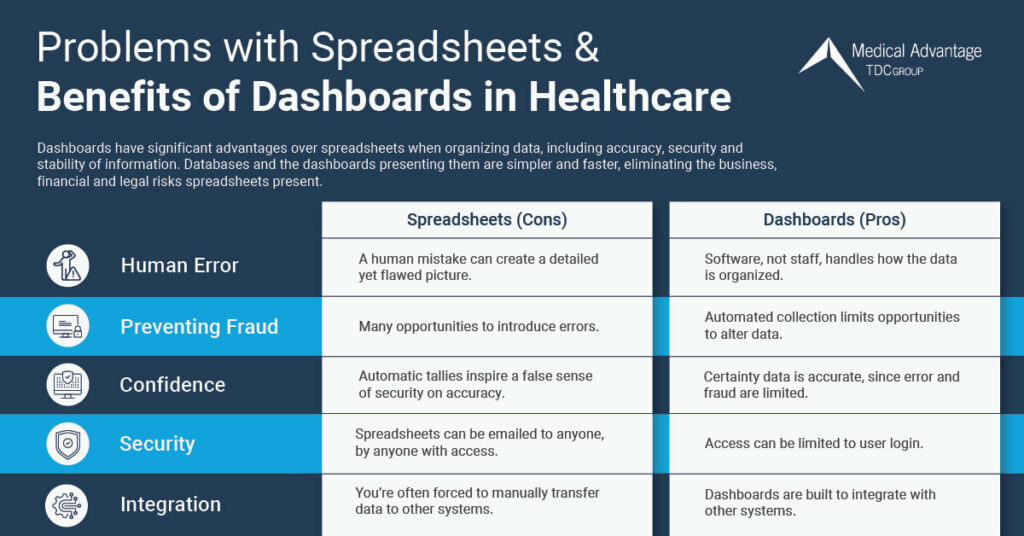Medical practices that employ a spreadsheet instead of more robust solutions such as a database in healthcare to manage rich data face numerous challenges. Those challenges involve the accuracy, security and stability of the data managed therein. Databases and dashboards are simpler and faster from the user’s standpoint and they eliminate the business, financial and legal risks present when relying solely on spreadsheets.
Pitfalls and Problems with Using Spreadsheets For Medical Practice Data
Spreadsheets, at first glance, may seem a natural choice for organizing medical practice data. With various data from multiple sources that need to be made intelligible for reporting purposes, spreadsheets are thought to be the more straightforward and most easily accessible solution for most lay users. But there happen to be several drawbacks to this approach. Anyone familiar with incessant spreadsheet over- and misuse in the healthcare world can likely list many related debacles; hence they would be hard-pressed to not choose databases and dashboards over spreadsheets, if given the option.
Real world spreadsheet disasters are well known -many meant millions, sometimes billions, of dollars lost when crucial information was garbled.
Take the case of JP Morgan Chase’s $6.5 billion copy-paste horror story, for instance. In 2012, an employee copied the wrong information from one spreadsheet to another while creating value-at-risk models in Microsoft Excel, skewing their synthetic credit portfolio. The error led to JP Morgan Chase’s biggest financial loss on record.
The European Spreadsheet Risks Interest Group (EuSpRIG), in fact, lists numerous spreadsheet pitfalls, as does Hubspot. A few of the more prominent of those hazards include:
- Human error: Spreadsheets are error-prone. Raw data entry alone, in human hands, can create a seemingly detailed yet flawed picture with a single mistake.
- Fraud: Spreadsheet data is easily manipulated, and therefore it is difficult to control for quality. Spreadsheets require additional safeguards, including version control and editing hierarchies, which are often not built into most organizations’ business practices.
- Overconfidence: Spreadsheets’ ability to automatically tally and organize data storage inspires a false sense of security regarding their accuracy. Intricate detail is only useful if that detail is based on an accurate starting point.
- Not secure: Spreadsheets can be emailed to anyone
,by anyone who has access to them. Each person with access to a spreadsheet increases the chance of further leaks, and such risk becomes considerable as an organization grows. This is a particular concern given practices’ obligations under the Health Insurance Portability and Accountability Act of 1996 (HIPPA), setting data storage privacy and security standards for medical information.
- Lack of integration: You’re often forced to transfer data into other business systems. Each time you do that, the likelihood of corrupted data must be considered, guarded against, and checked for. Such lack of a single source of truth is a major drawback with spreadsheet use.
Using Dashboards to Integrate Several Databases
Combining data across several sources can be complicated if you rely on a spreadsheet vs. database in healthcare. But integrating with the databases directly gives you the easiest and most linear access to the data.
Use of spreadsheets contributes to an organization’s data silos – separate sources of information that aren’t part of an organization’s enterprise-wide data management system. Spreadsheets, Electronic Health Records (EHRs), payroll systems, and scheduling software all silo vital information away from a consolidated source which hinders easy assessment and insightful integration.
Dashboards — software tools that automate the integration of those disparate silos into one central view — address spreadsheets’ weaknesses. Reports and charts provided by dashboards can be created from complete, organized, and accurately software-curated information.

Benefits of Database Integrated Dashboards over Spreadsheets for Healthcare
Dashboards which sit atop a data warehouse provide quicker access to information and allow for greater confidence in that information. The means by which data from various sources are accessed allow for fewer opportunities to intentionally or mistakenly alter information. The process, using relational databases, organizes data based on its common elements, limiting human error.
Dashboards counter spreadsheets’ main disadvantages by:
- Limiting human error: No system is completely free of human error, but dashboards provide some assurance against such error being a factor. Software, not staff, handles how the data is organized once it is generated at your practice.
- Preventing fraud: When software collects the data used in your reports, opportunities to manipulate that data in a clumsy or even malicious way are minimized.
- Inspiring confident action: The functions dashboards use to organize data aren’t open to editing by whomever happens to access them, unlike spreadsheets. Also, you can be reasonably certain the data is accurate, since error and fraud are also limited.
- Being more secure: Dashboard access can be limited to specific people, and the views and access itself can be made dependent upon user login credentials. Also, the reports are derived from more secure databases.
- Easily integrating with other systems: Dashboards are built to easily integrate with other systems, greatly increasing their utility. Those integrations are automated, preventing human error from introducing corrupted data into the system.
- Consolidate information: Access data in one centralized view.
- Scale easily: Automated data collection supports practice growth by being easier and faster.
- Perform real-time analysis: Better informed decisions are possible with accurate answers at your fingertips.
What Your Practice Can Do With Healthcare Dashboards
More often than not, you’re better off forgoing a spreadsheet vs. database in healthcare, given the advantages and business insights gained by the latter approach.
With healthcare dashboards, your practice will have immediate access to secure, reliable healthcare performance metrics curated from throughout your practice. Dashboards can be organized to display comprehensive analyses of patient volume, patient visits, practice finances, and services.
Let’s explore some examples of healthcare performance metrics in detail:
- Patient visits – Understand who visits your practice, when, for how long, and for what services. Such insights help with planning, such as staffing.
- Patient demographics – Run demographic reports on patients’ age, insurer, gender, and home address to better serve and engage those patients – and attract new patients who share a similar profile. Such insights will inform more effective care for new and existing patients.
- Patient services – What services are most in demand from your patients? You may want to shift resources into that area to make sure their needs are met successfully. It might also be handy to know which services are experiencing less demand, particularly if they draw higher revenue.
- Finance – Track charge and payment trends, and filter by insurer, location, and physician. See which claims are approved or denied. Knowing these trends will help maximize revenue and provide confidence that care will be covered.
- Quality – Shifts toward value-based care (VBC) will be necessary for your practice sooner or later. Reimbursement will increasingly depend on being able to demonstrate your practice is meeting quality metrics, making a healthcare quality dashboard an indispensable part of your business’s healthcare analytics.
Dashboards provide accurate, reliable insights into how your practice works, who it serves and how you can best organize to provide the best care in a way that is more useful to patients, resulting in a more profitable practice that delivers better patient outcomes.
With dashboards providing critical insights, your team can focus on aspects that are underperforming, then redirect resources and refine strategy as needed. That will result in better care and increased profitability.
Medical Advantage’s Dashboard Solutions Can Help
Healthcare dashboards – like the ones facilitated by the experienced medical experts at Medical Advantage – enable private equity groups to avoid data silos in healthcare and provide vital healthcare performance metrics. Our dashboard optimization also enhances operations, improves care quality, and boosts revenue. See which of our healthcare dashboards solutions are right for you.





